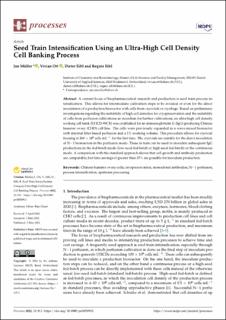Bitte benutzen Sie diese Kennung, um auf die Ressource zu verweisen:
https://doi.org/10.21256/zhaw-25306| Publikationstyp: | Beitrag in wissenschaftlicher Zeitschrift |
| Art der Begutachtung: | Peer review (Publikation) |
| Titel: | Seed train intensification using an ultra-high cell density cell banking process |
| Autor/-in: | Müller, Jan Ott, Vivian Eibl, Dieter Eibl-Schindler, Regine |
| et. al: | No |
| DOI: | 10.3390/pr10050911 10.21256/zhaw-25306 |
| Erschienen in: | Processes |
| Band(Heft): | 10 |
| Heft: | 5 |
| Seite(n): | 911 |
| Erscheinungsdatum: | 2022 |
| Verlag / Hrsg. Institution: | MDPI |
| ISSN: | 2227-9717 |
| Sprache: | Englisch |
| Schlagwörter: | Chinese hamster ovary cell; Cryopreservation; Monoclonal antibody; N−1 perfusion; Process intensification; Upstream processing |
| Fachgebiet (DDC): | 660.6: Biotechnologie |
| Zusammenfassung: | A current focus of biopharmaceutical research and production is seed train process intensification. This allows for intermediate cultivation steps to be avoided or even for the direct inoculation of a production bioreactor with cells from cryovials or cryobags. Based on preliminary investigations regarding the suitability of high cell densities for cryopreservation and the suitability of cells from perfusion cultivations as inoculum for further cultivations, an ultra-high cell density working cell bank (UHCD-WCB) was established for an immunoglobulin G (IgG)-producing Chinese hamster ovary (CHO) cell line. The cells were previously expanded in a wave-mixed bioreactor with internal filter-based perfusion and a 1 L working volume. This procedure allows for cryovial freezing at 260 × 10<sup>6</sup> cells mL<sup>−1</sup> for the first time. The cryovials are suitable for the direct inoculation of N−1 bioreactors in the perfusion mode. These in turn can be used to inoculate subsequent IgG productions in the fed-batch mode (low-seed fed-batch or high-seed fed-batch) or the continuous mode. A comparison with the standard approach shows that cell growth and antibody production are comparable, but time savings of greater than 35% are possible for inoculum production. |
| URI: | https://digitalcollection.zhaw.ch/handle/11475/25306 |
| Volltext Version: | Publizierte Version |
| Lizenz (gemäss Verlagsvertrag): | CC BY 4.0: Namensnennung 4.0 International |
| Departement: | Life Sciences und Facility Management |
| Organisationseinheit: | Institut für Chemie und Biotechnologie (ICBT) |
| Enthalten in den Sammlungen: | Publikationen Life Sciences und Facility Management |
Dateien zu dieser Ressource:
| Datei | Beschreibung | Größe | Format | |
|---|---|---|---|---|
| 2022_Mueller-etal_Seed-train-intensification_processes.pdf | 5.29 MB | Adobe PDF |  Öffnen/Anzeigen |
Zur Langanzeige
Müller, J., Ott, V., Eibl, D., & Eibl-Schindler, R. (2022). Seed train intensification using an ultra-high cell density cell banking process. Processes, 10(5), 911. https://doi.org/10.3390/pr10050911
Müller, J. et al. (2022) ‘Seed train intensification using an ultra-high cell density cell banking process’, Processes, 10(5), p. 911. Available at: https://doi.org/10.3390/pr10050911.
J. Müller, V. Ott, D. Eibl, and R. Eibl-Schindler, “Seed train intensification using an ultra-high cell density cell banking process,” Processes, vol. 10, no. 5, p. 911, 2022, doi: 10.3390/pr10050911.
MÜLLER, Jan, Vivian OTT, Dieter EIBL und Regine EIBL-SCHINDLER, 2022. Seed train intensification using an ultra-high cell density cell banking process. Processes. 2022. Bd. 10, Nr. 5, S. 911. DOI 10.3390/pr10050911
Müller, Jan, Vivian Ott, Dieter Eibl, and Regine Eibl-Schindler. 2022. “Seed Train Intensification Using an Ultra-High Cell Density Cell Banking Process.” Processes 10 (5): 911. https://doi.org/10.3390/pr10050911.
Müller, Jan, et al. “Seed Train Intensification Using an Ultra-High Cell Density Cell Banking Process.” Processes, vol. 10, no. 5, 2022, p. 911, https://doi.org/10.3390/pr10050911.
Alle Ressourcen in diesem Repository sind urheberrechtlich geschützt, soweit nicht anderweitig angezeigt.